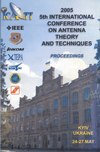FDTD simulation of videopulse scattering by elliptic objects in different media
DOI:
https://doi.org/10.1109/ICATT.2005.1496981Ключові слова:
videopulse, GPR, computer simulation, FDTD-method, radar imageАнотація
The results of computer simulation of videopulse scattering in inhomogeneous media containing conductive cylinder objects are presented in this work. The finite difference time domain method (FDTD) and Mur’s absorbing boundary conditions of second order were used to solve the problem. The GPR images of the researched objects were built. The analysis and comparison of scattered electromagnetic fields for different sizes and locations of conductive objects were carried out.Посилання
TAFLOVE, A. Computational Electrodynamics. The Finite-Difference Time-Domain Method. Boston-London: Artech House, 1995.
YEE, K.S. Numerical solution of initial boundary value problems involving Maxwell's equations in isotropic media. IEEE Trans. Antennas Propag., May 1966, v.14, n.3, p.302-307, doi: http://dx.doi.org/10.1109/TAP.1966.1138693.
TAFLOVE, A.; BRODWIN, M.E. Numerical solution of steady-state electromagnetic scattering problems using the time-dependent Maxwell's equations. IEEE Trans. Microwave Theory Techniques, Aug. 1975, v.23, n.8, p.623-630, doi: http://dx.doi.org/10.1109/TMTT.1975.1128640.
MUR, G. Absorbing boundary conditions for the finite-difference approximation of the time-domain electromagnetic-field equations. IEEE Trans. Electromagnetic Compatibility, Nov. 1981, v.EMC-23, n.4, p. 377-382, doi: http://dx.doi.org/10.1109/TEMC.1981.303970.
VARYANITZA-ROSHCHUPKINA, L.A.; KOVALENKO, V.O. Pulse scattering on objects in the inhomogeneous conducting medium. Radio Physics and Radio Astronomy, 2002, v.7, n.4, p.435-440.
GOLOVKO, M.M.; POCHANIN, G.P.; KOVALENKO, V.O. Representation of results of videopulse sounding. Radiophysics and Electronics, 2000, v.5, n.2, p.134-143.

